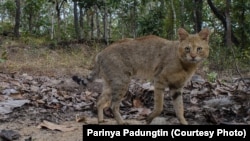The sighting of rare jungle cats in northern Thailand has buoyed environmentalists and conservationists concerned that habitat loss and animal poaching are contributing to the species' decline.
The jungle cats (Felis chaus) are found across a diverse region of the globe -- from Egypt, West and Central Asia, South Asia, Sri Lanka and Southeast Asia -- and are considered a key indicator of wildlife conservation.
But conservationists say the jungle cat faces growing pressure across the world as its habitat is reduced by human intervention.
Two cats were caught on "camera-trap" in early January on the Omkoi Wildlife Sanctuary in northern Thailand's Chiang Mai province.
Thanya Nethithamkul, director general of Thailand's National Park, Wildlife and Plant Conservation Department, told local media it may have been up to four decades since jungle cats were last seen in the wild in Thailand.
"We thought jungle cats were lost to our forests. Locals have claimed to have seen them, but there was no evidence proving their existence. But this time we have pictures to show their presence," Thanya said.
Photographer Parinya Paduntin was working with a team of research assistants from the Doi Chiang Dao Wildlife Research Station.
Parinya told VOA a sensor triggered camera was mounted in the park for two weeks in early January. The images of the rare cats sparked great excitement, he said.
"I felt great. We all thought [the jungle cat] was already extinct. You cannot describe it we were speechless. It's a great success," Parinya said. "If we could scream out we would have. It was so exciting. There was a chaos moment wanting to report the news to all my friends to say what had happened."
Edwin Weik, founder of the Wildlife Friends Foundation of Thailand, said while not extinct in Thailand, the jungle cat remains on the list of critically endangered species in Thailand.
Anak Pattanavibool, director of Thailand's Wildlife Conservation Society, said the sighting was "very important".
"The record of jungle cats these days, they are very rare and in Thailand a lot of good people believe it may have gone already," Anak told VOA. "But this time, the person who used this high quality camera trapping system, got very good quality photos of the cat; very clear, very beautiful. It's very, very important to confirm," he said.
Jungle cats and other similar species are facing ongoing challenges in the region, where in many parts of Asia their populations have been in decline due to trapping, snaring and poisoning.
The International Union for the Conservation of Nature (IUCN) has the jungle cat listed as "least concern" on the IUCN's "red list of threatened species".
Under the Convention on International Trade in Endangered Species of Wild Fauna and Flora (CITES) jungle cats are listed under Appendix II meaning while not necessarily threatened with extinction, trade needs to be controlled to avoid threats to their survival.
The IUCN says a scarcity of jungle cats in mainland Southeast Asia "is likely the result of high levels of hunting in open and accessible" forest areas.
In Cambodia, in particular, the IUCN says all the protected areas "are insufficiently managed and threatened by habitat loss, degradation and hunting."
Anak says the sighting of the jungle cats comes as their habitat more generally is disappearing.
"Most of the jungle cats have gone because of habitat disruption the loss of grass, the open woodland habitat," Anak said. "This is the habitat that is still remaining in very, very small pockets in northern Thailand so it's very important we have to try to save this habitat."
Thailand, pressed by the international community and CITES conventions, has taken steps to curb its role as a wildlife trafficking hub, especially in areas such as ivory shipped illegally from Africa and bound for markets in China and Vietnam.
Thai wildlife and customs officials have succeeded in uncovering operations trafficking pangolins, turtles, and tiger parts and bones for markets, especially in China.
Kraisak Choonhavan, chairman of the non-government Freeland Foundation, monitoring wildlife trafficking, said the discovery of the jungle cats is set against the dangers and challenges of curbing trafficking and poaching.
Kraisak said in recent years some 30 Thai wildlife rangers have been killed by poaching gangs who often have travelled from nearby countries.
"In areas where we call animal sanctuaries along the border with Burma [Myanmar] and with Laos this is where we considered as the richest area for bio-diversification of fauna and flora," he told VOA. But the region is highly vulnerable to poaching gangs.
"People do come in illegally to kill wild animals here. We have even found that companies in China would hire Cambodians, armed militias to come into Thailand and hunt animals and cut the [protected] wood redwood and other perfumed woods that sets high values in China itself," Kraisak said.
Thai National Park director general Thanya refused to reveal where exactly the two rare jungle cats were sighted. But he added the presence of the cats pointed to a healthy forest in the Omkoi Wildlife Sanctuary.
Rare Jungle Cats Sighted in Northern Thailand
- Ron Corben
- VOA News

BANGKOK —






